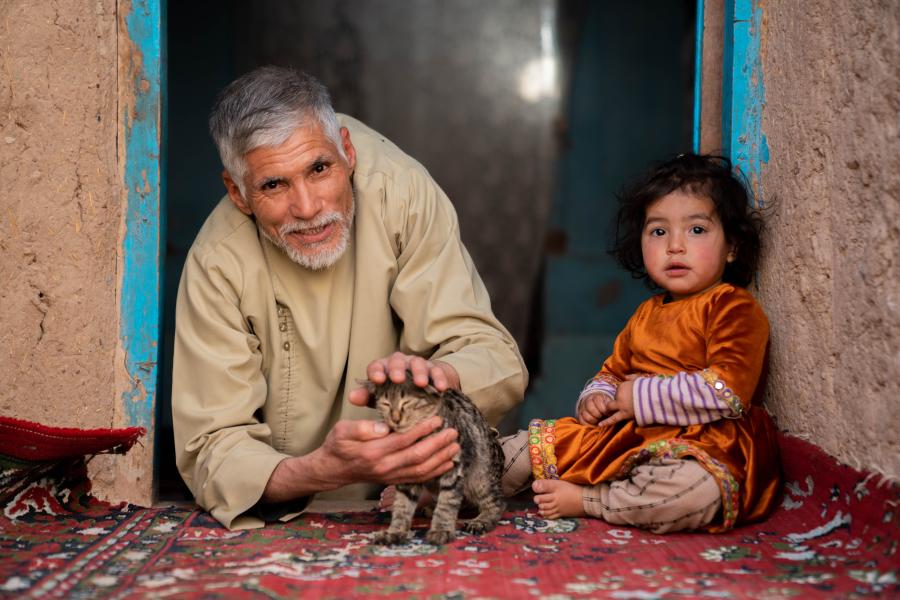2021 Year-end population figures
- Refugees and asylum seekers: 2.3 million, 25% women and 48% children
- IDPs: 3.5 million, 21% women and 58% children
- New IDPs in 2021 alone: 777,000, 57% children and 21% women
- IDPs returns: 791,000
2021 situation overview
The humanitarian situation in Afghanistan worsened significantly in 2021. Prior to the Taliban’s takeover of power in August, the United Nations Assistance Mission in Afghanistan (UNAMA) had reported the highest number of conflict-related casualties on record and a striking decline in the security and human rights situation in large parts of the country.
The displacement of 777,000 people (57% children and 21% women) brought the total number of people displaced by conflict inside Afghanistan to 3.5 million as of December 2021. The conflict diminished and humanitarian access to many parts of the country improved after the Taliban takeover and the announcement of an interim government, but there was deepening poverty, exacerbated by drought, COVID-19 and food insecurity. With ongoing restrictions and systematic exclusion, women and children faced heightened protection risks including intimate partner violence and child marriage.
Since August 2021, women have largely been excluded from the workforce both as a result of the economic crisis and restrictions imposed by the de facto authorities. In the public sector, exceptions were made in some cases for women working in health care and primary schools, as well as for a very small number of civil servants. Limitations on freedom of movement negatively impacted other aspects of women’s lives, including access to health services. The closure of many women’s protection shelters left women at risk. Justice systems established to deal with cases of gender-based violence were largely non-functional.
In the last quarter of 2021, UNHCR significantly expanded operations countrywide and rapidly scaled up its staffing and field presence in response to dramatically increasing needs, while also assisting internally displaced people who began returning to their areas of origin as soon as the conflict calmed. Psychosocial support-focused activities were introduced based on the findings of the “Whole of Afghanistan assessment 2021” conducted by REACH in the context of the 2021 Humanitarian Programme Cycle, which showed a high level of needs for mental health and psychosocial support (PSS) services (66% of men and 61% of women in assessed households reported at least one behavioural change in 2021).
In response, UNHCR scaled up its PSS response and assisted 14,000 people with psychosocial counselling either in person or remotely, of which 65% were female, while 47,000 women and girls received dignity kits. UNHCR expanded its area-based approach to 55 Priority Areas of Return and Reintegration (PARRs) to meet middle- to long-term development objectives in the areas of health, education and livelihoods. UNHCR constructed, rehabilitated or expanded 37 schools across the country, supporting 44,000 primary, middle and high school students. 10 health centres and clinics were also constructed in the country, benefiting 364,000 individuals, while 16,000 people received livelihood support. Overall, 791,000 Afghan internally displaced returned home between August and December 2021 as the situation in the country stabilized, according to rapid assessments conducted among 153,700 households in 333 districts, in all 34 provinces.
In Central Asia and the Islamic Republics of Iran and Pakistan, together hosting 2.2 million registered Afghan refugees, UNHCR and partners supported preparedness activities via the Regional Refugee Response Plan. Some 158,000 newly arrived refugees in these countries approached UNHCR in 2021, although the true figure of those in need of international protection is likely to be much higher. At the invitation of the Government of Uzbekistan, UNHCR established a humanitarian and logistics hub in the town of Termez, bordering Afghanistan, and made it available to other humanitarian agencies. Serving the entire region, the hub enhanced pre-positioning and rapid delivery of core relief items to Afghanistan.
In line with the Solutions Strategy for Afghan Refugees, UNHCR continued to support inclusive policies by channelling investment into national public service delivery systems, especially in health and education. The Government of Pakistan successfully implemented the Documentation Renewal and Information Verification Exercise (DRIVE) with the support of UNHCR, verifying the data of Proof of Registration (PoR) cardholders in Pakistan and issuing new PoR smartcards to all eligible refugees. Some 1.28 million refugees were verified during the exercise (including previous PoR Card Holders and new birth registrations) but there were also 238,000 people in a refugee-like situation in Pakistan (including unregistered members of registered families and newly arrived Afghans).
Across the Afghanistan Situation in 2021, UNHCR provided $35 million in cash assistance to 836,000 people of concern and assisted 64,300 households with core relief items and 6,600 households with emergency shelter.
